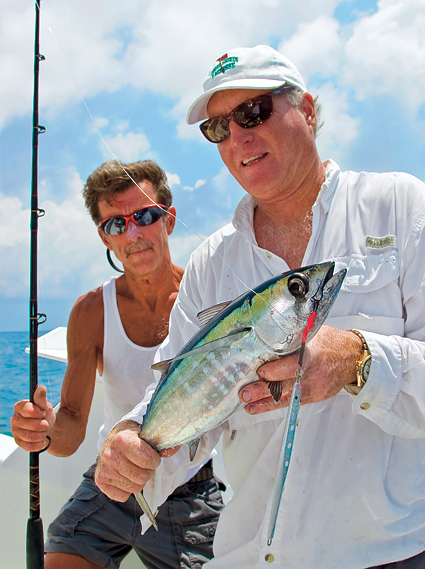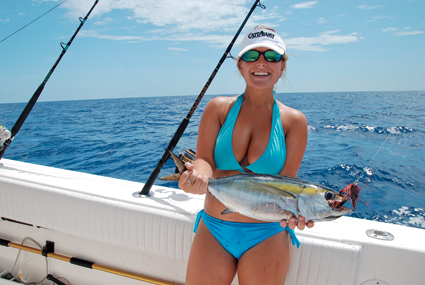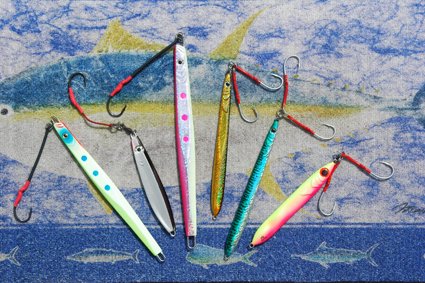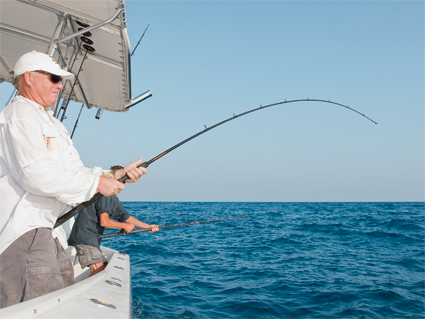September 01, 2009
By Al Herum
Catch blackfin tuna the easy way—no livies, no trolling necessary.

Fast-falling 7-ounce jig proved the undoing of this spunky blackfin tuna. |
Sometimes a little competition is a good thing. Our two-boat trip to jig up a few blackfin tuna turned into just that, a little friendly competition. Three of us on one boat would go head-to-head against a crew of high schoolers. Our “old guy” crew consisted of a pair of seasoned anglers and a rookie, while my son's team, on another boat, was a foursome of headstrong teenagers, each with all the cranking power of an electric reel.
Our plan was to make some quick drops on the Islamorada Hump for a few tasty blackfins prior to heading farther offshore in search of dolphin. Of course, with two boats to load and a bunch of teenagers as part of the crew, it is almost superfluous to report that we didn't get off the dock at dawn or anywhere close. It was more on the order of late morning—with an arrival at the Hump as the sun was high. Certainly not the best time of day to coax tuna to bite.
Still, our first drops at the big seamount 12 miles southeast of Islamorada resulted in a tripleheader of hookups for the crusty old school crowd and a few swings and misses for the younger set. What made the difference? Well, youth being what it is, they decided to run right into the mix of trolling boats at the Hump, not paying much attention to where exactly they were and what the current might be doing. Instead, they just stopped and dropped. Once their jigs were down a ways, I could see from a distance a couple kids working like mad—rodtips jerking from the surface to high overhead and back down, again and again.
Our crew took a more leisurely initial approach. We idled in until the top of the Hump, in about 300 feet of water, was clearly defined on our sounder. Then we went dead stop to get a quick look at the current and drift. Winds were light, so all the boat movement was current-driven. And it was moving pretty fast, too. On the GPS we were showing a steady 2- to 3-knot drift. With the current speed and our exact location determined, we pointed our boat directly upcurrent of the Hump's high spot and ran for about 500 feet. That would be our starting point for the first drift. As soon as the boat came to a stop, all three of us dropped jigs toward the bottom.

Trolling small lures is another easy technique. |
Dropping to 300 or 400 feet can take some time, even with a heavy jig, so planning the drift is key. The idea is to get a bite before you hit bottom. Still, you'd like to have enough drop time to get the jig to or near the bottom at about the same time the drifting boat nears the top edge of the rapidly rising southwest face of the Hump. If we were not making it down in time we'd have extended the upcurrent run a little. Or, we would have shortened it if we were hitting bottom too far down the face.
Our first guess seemed to work pretty well, as all three of us hooked up before we reached the bottom or the boat reached the peak of the seamount. We ended up landing three fat blackfins, respectable fish between 5 and 10 pounds. Not bad for the first drop.
After a little education as to where to start the drift, my son's crew got the hang of it and started banging doubleheaders on nearly every drift. In addition to getting the kids drifting right, we gave them some tips on jigging with what has become known as a “butterfly jig” (the term is more accurately applied to the proprietary Shimano models, while “speed jig” seems a better catch-all). These types of slim, metallic jigs don't require the high-stick jigging technique many of us mastered when leadhead bucktails were the rage. With the butterfly, you've got to let it flutter down, then just wind it back up. Most tuna bites you'll get on the descending flutter or the retrieve. It seems actually jigging these jigs is nothing but wasted energy.
You need to play close attention as line pays out on the drop. Usually a take on the drop is signaled by the jig stopping suddenly. If that happens, lock up the reel and wind fast. Hopefully you'll come tight and feel the fish; if not, re-drop immediately. Occasionally a tuna will whack the jig and miss the hooks. They'll usually be back for another bite if you drop again. Sometimes you'll make it to the bottom and not get a bite—if you do, just start winding the jig back to the top at a moderate pace. Often a tuna will chase and hit the rising jig.
Sometimes dropping all the way to the bottom results in hooking up an amberjack. If you don't want to keep fighting these mules on light tackle, try shortening your subsequent drops.
Our most experienced anglers outfitted themselves with 15-pound-class levelwind plug gear spooled with 15-pound-test monofilament. After doubling the mainline with a Bimini twist, we added a 4-foot section of 25-pound-test fluorocarbon leader. Blackfin tuna are notoriously line-shy; the fluorocarbon is useful due to its comparatively low transmission of light under water. The small teeth of blackfin tunas make it unnecessary to use leader much heavier than 25-pound-test, but for general fishing in areas where you might expect kingfish or wahoo, there's a tradeoff to consider: at $10 or $12 a shot, sacrificing jigs gets expensive. Best to bump up the leader size accordingly unless you are confident that tunas are the main customers, as is typically the case on the deepwater humps along the Florida Keys.

Left to Right, three Williamson Benthos and Vortex speed jigs and three Bomber Vamp and Darter models. |
With most of these jigs, tie the leader to the same ring that holds the hook(s); the hooks stand out on heavy-duty polyethylene droppers. We used 3.5- and 5-ounce jigs on the 15-pound gear. Both produced good results.
Our youth gang geared up with 20-pound-class conventional gear rigged with 30-pound fluorocarbon leaders and 5- or 7-ounce jigs. After some wear and tear on a number of fish, these guys cut off the leaders and tied straight to the mainline and kept bringing blackfins over the rail on nearly every drift.
Our rookie angler was set up with a beefy 30-pound-class trolling outfit spooled with 50-pound braided polyethylene line. This class braid has the diameter of 12- to 15-pound mono so our newbie had no problem getting down with a 7-ounce jig.
Anglers who specialize in this type of tuna jigging rig up a rod specifically for this task. A 15-pound-class baitcasting outfit spooled with a 20- to 30-pound braid is about perfect. Fit this reel to a 7-foot medium-duty rod and you'll get down with ease with only a 2- to 3.5-ounce jig. Double the mainline on an outfit like this with a 50-turn Bimini twist and then add a 10-foot section of 25-pound fluorocarbon leader.
You can find schools of blackfin tuna seasonally on all of the Florida Keys seamounts and offshore wrecks; if you move around a bit and stay tuned to local reports, you can jig up a blackfin on most days of the year. However, after talking to a number of top Keys skippers, we'd have to say the prime months for blackfin tuna in the Keys is the entry and exit of our winter season. A Florida Keys winter begins in November and December and ends in March and April. The consensus is that the spring months are best in the Middle and Upper Keys, while the late fall and early winter months are best in Key West and the Lower Keys.

Multiple tuna hookups are expected when you time the drift right. |
Top spots for blackfins in the Middle Keys include the Islamorada Hump, where we fished; the 409 Hump; and the Marathon or West Hump. If you review a bathymetric chart you'll see a number of other unnamed humps, mostly located between the Islamorada and Marathon Humps; these are always worth a drop or two. Your best shot off Key Largo is the Key Largo Hump or one of the deep wrecks. In the Key West area, the Sub wreck and the west end of the bar are two top spots.
We won't get into who actually won our little competition that fine day. But let's just say old guys rule and teenagers drool.
FS

